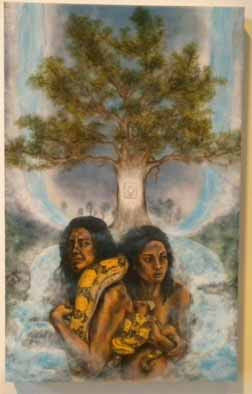The paintings, for the most art, are in pristine condition; it seems like no time has passed. The presence of calcite crystals on the paintings is evidence that these works are indeed real and not fake; they've just had the good fortune of been in an environment that was safe from rain and wind (the cave had collapsed tens of thousands of years ago, forming a protective germ-free environment) Although this movie is billed as a documentary, it's also very much an art film.
One of the first things that popped into my mind when looking at this Neanderthal cave art was "Why does this work seem so fresh and immediate? And why does so much current artwork look so dated?" That was a paradox that I was constantly reminded of: the prehistoric work seemed to have a spirit and a presence that was very much in the "now", whereas as the "modern" work just mentioned seemed faddish and false. The cave drawings at Chauvet cave has a life and fluidity that just draws you in; you can sense the presence of artist as a real personality, right there with you.
One thing that I really thought was great were the types of animals in the cave murals. All of them were of species that no longer exist. Commentators talk about the "horses" and the "bulls" in the murals, but what's actually there (at least what I see) are prehistoric creatures that are now extinct. There is a creature that looks like a horse, but it's not a horse: it's neck is too short and thick, and it's mane is actually like a scrub brush that lies across his back. There's also something unusual with the shapes of these creatures heads, and the size the their ears (which are much smaller than a horses ears). These are some relative of a horse, but they're not horses. However, they are a peek into the past about what kinds of creatures actually roamed the earth. The same goes for the drawings of a "bull". If you look closely, it's actually not a bull, but rather, a giant rodent with tusks. Go on, have another look! These murals are great not just for the talent of the artist, but also for his eye witness account of now-extinct animals.
Another thing I enjoyed in this movie is that the researchers were able to identify one of the artists! There were multiple types of art in the cave artwork in Chauvet cave: the animal paintings, non-objective art (red dot patterns), some abstract symbols that looked vaguely like insects and butterflies, and printing (hand prints). I was really impressed with the skill and the sensitivity of these Neanderthal painters. But I was also impressed at how much of modern art history was "anticipated" (hah! yeah, right...) by these Neanderthals. Many of the hand prints had a bent pinky finger: this was hist signature. That bent finger print showed up in multiple places in the cave. Thus, much of this cave art can be traced to an individual artist!
Lingering in the back of my mind was the question "why are these artists painting on the cave walls?" No one knows if these murals were part of a theatrical presentation, a religious ceremony, or simply as a backdrop for a display of art. The researchers in the film note that while there are many bones in the cave (usually of a prehistoric bear), there are no human bones in there. Perhaps the cave was used as a theater? No one knows...
As you can see, I really enjoyed this movie! A great art flick! And a great discovery an an amazing artist: Mr. Crooked Pinky Finger.
It's said that life if short, but art is long. Here's the proof.






















































